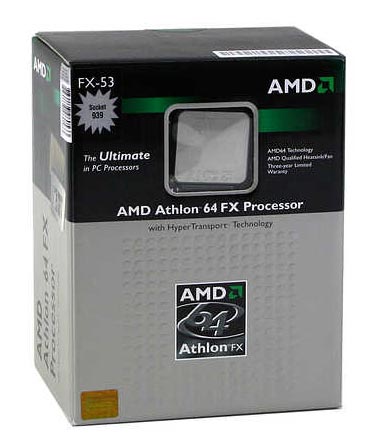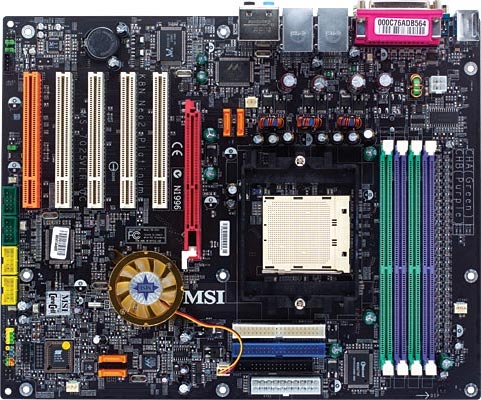Overclocking Buyer's Guide - September 2004
by Wesley Fink on September 17, 2004 12:05 AM EST- Posted in
- Guides
CPU and Motherboard: PERFORMANCE OC Recommendations
CPU: AMD Athlon 64 FX53 (2.4GHz 1024K L2 cache)Motherboard: MSI K8N Neo2 (nForce3 Ultra)
Price: CPU - $850 shipped (Retail). Motherboard - $139 shipped

For Overclockers looking for the best performance possible, it would be tough to recommend anything other than the Athlon 64 FX53. The Athlon 64 is currently the fastest processor that you can buy; the Dual-Channel Socket 939 is the top-performing A64 Socket, and the FX is the fastest 939 processor. The FX also has the distinction of being the only processors that are completely unlocked. That means that you can adjust multipliers both up and down, to obtain the highest possible speed at the fastest DDR400 memory timings, or to obtain the highest FSB that your high speed memory can run or your CPU can reach. Most FX53 that we have tested easily reach 2.6GHz at default voltage with air cooling, and some do even better. This pegs performance at a clock speed that we won't see in a retail CPU until late this year.
While the 3500+ (2.2GHz) can reach similar speeds, it is still multiplier locked at the top (lower multipliers can be selected, though) and the cache is only half of what is found on FX53. The 3800+ runs at the same 2.4GHz with half the cache, but again, the regular Athlon 64 are top-locked, and the small price difference between FX53 and 3800+ makes it difficult to choose the 3800+ over the FX53. What you get in the FX53 is the fastest stock performance currently available among desktop processors, and the ability to reach even higher. AMD does not call the FX series their Enthusiast CPU for nothing. There are no locks to hold you back and the real limit is what the .13 process can do with Athlon 64. Based on how very well the FX53 has performed in our tests in recent reviews, we can hardly wait to test the new 90nm process FX chips that should become available at the end of the year.

After a couple of months of waiting, the MSI K8N Neo2 is now widely available in the retail channel. The K8N Neo2 stood out in our Socket 939 roundup as a top performer and earned the AnandTech Gold Editor's Choice. Perhaps even more important to an overclocker, the K8N Neo2 was the only board in the 939 roundup to match and actually edge ahead of the standout memory performance of the legendary Asus P4C800-E in our overclock tests. The K8N Neo2 actually reached a Clock Frequency of 290 (DDR580) with fast DDR550 memory that we used in our overclock tests. Wherever you can take the FX53, the K8N Neo2 will go - to the limits of your CPU or memory.
While the overclocker will likely turn off most everything when pushing boards to the limit, when the day is done and the system returns to more sedate levels, the K8N Neo2 will continue to impress with a full implementation of the features of the nForce3-250Gb/Ultra including fast on-chip LAN, any-drive RAID that allows IDE and SATA hard drives to be combined in RAID arrays, and an on-chip Firewall. The feature set compares well to any premium Socket 939 on the market and will not disappoint.
For the best overclocking experience, you can count on a working AGP/PCI lock with adjustments from 66 to 100, CPU multipliers from 4X to 20X, HyperTransport adjustments from 1GHz to 200MHz (5x-1x), and CPU frequencies from 200 - 451. You also get a full range of voltage adjustments - vCore to 1.85V, memory voltage to 2.85V, and vAGP to 1.85V. This is even a board for the beginning overclocker, since there are automatic overclocking selections in Core Cell that set everything for you. You just choose the % overclock from 1% to 11% and the board does the rest.
We have never tested a perfect board, but we are impressed by the improvements that MSI has made to the K8N Neo2 with recent BIOS updates. The CPU frequency range has now been raised to 451 from the previous 300. MSI also listened to the suggestions made by AnandTech and other sites, and has added finer 0.5X adjustments for CPU ratios, providing greater control in overclocking the K8N Neo2. There is no real voltage adjustment for HT or chipset voltage, and that would add to the flexibility of this excellent board. In the end, it's hard to complain about a board that does so much so well, particularly when MSI has paid close attention to suggestions for improvement. The MSI reached 290x9 (2610) with fast memory, and for those who prefer raising the ratio, 2652 was an easy 13x204. Since all of these were at near stock voltages, serious overclockers will find ways to get even more from an FX53 on the MSI K8N neo2.
Listed below is part of our RealTime pricing engine, which lists the lowest prices available on the AMD CPUs and motherboards from many different reputable vendors:
If you cannot find the lowest prices on the products that we've recommended on this page, it's because we don't list some of them in our RealTime pricing engine. Until we do, we suggest that you do an independent search online at the various vendors' web sites. Just pick and choose where you want to buy your products by looking for a vendor located under the "Vendor" heading.










31 Comments
View All Comments
jeeptrkr - Friday, December 10, 2004 - link
Perfect timing and very infomative article. I'm looking to buy a MSI K8N Neo2 Platinum w/ an AMD 64 FX-55 cpu.How would Crucial Ballistix PC4000 2.5-4-4-8 compare to PC3200 2-2-2-5 on the MSI mb? Faster bandwidth ver tighter timings?
decptt - Thursday, September 30, 2004 - link
Thank you, Fink.I ran Athlon64 Mobile 3200 2.0@2.55 Vcore 1.8
I will drop to 10x250 vcore1.7 for safer :>
Ballistix run@ 1:1 2.5-4-4-8 (I don't want to set 2.5-3-3-5 like the review for make sure that it works fine)
I'll tell the testing result again.
P.S. I had reached to 10x260 V1.8, windows works but Prime95 doens't work stable.
southernpac - Sunday, September 19, 2004 - link
Wesley,If Raid 1 is used (mirrowing), is the slow down negligble for a simulations gamer - or would it be noticable? Would the same be the case with 7,200 rpm SATA's?
I also notice that you listed the eVGA 6800, but the July High-End Guide listed the Gigabyte 6800 (Ultra). Have you noticed performance or manufacturing differences between the 6800 vendors?
The photo of the Crucial Ballistik PC3200 512 memory has a CL113V.X1 part number on it. I can't find that part number listed on the Crucial web site. ? Bill Mackay
thebluesgnr - Saturday, September 18, 2004 - link
This is one interesting article, but I wish it had the same idea of a "Value" system as other AT articles. The Value system of this guide is too much for me, here's what I came up with:AMD Athlon XP Mobile 2400+ 45W $77
ASRock K7V88 Raid $44
512MB (1 X 512MB) Corsair Value Select DDR400 CAS2.5 $79
128MB GeCube Radeon 9550XT $99
Antec SLK3700-BQE Black ATX Midtower w/ 350W PSU $90
Seagate 80GB 7200RPM SATA (8Mb Cache) – ST380013AS $71
HSF not included, total of $460.
One could change that system to a Chaintech VNF3-250 + Sempron 3100+, but I would rather upgrade the video card first.
PrinceGaz - Saturday, September 18, 2004 - link
#25 Wesley Fink- its great to hear a Value RAM roundup is being planned, listening to and where necessary addressing your readers comments is one of the main reasons AT is such a valuable website.Gholam - Saturday, September 18, 2004 - link
You have a mistake on page 13 - you list CM Stacker as an all-aluminium case, while it definitely isn't. It has aluminium panels, but the chassis frame is made of steel. It also weighs 14.9kg... ouch. On the other hand, there is no other case where ducting the PSU is as easy...Wesley Fink - Saturday, September 18, 2004 - link
#24 - I mentioned in the Value conclusion that you can cut $300 by choosing a cheaper case and an ATI 9800 PRO instead. Perhaps I should make those recommendations part of the Value OC chart in the future.#22 - I recommended one 512MB stick of Crucial Ballistix to get the cost down on the lowest priced system and still have great overclocking. We do plan a Value RAM roundup in the future.
cnq - Saturday, September 18, 2004 - link
Wesley,Keep up the good work!
Only nit is that like last time, you "forgot" (maybe it was intentional) to present a value video card. The price of the video card stuck out like a sore thumb in the summary pricing table for the value system!
The power requirements are ugly, but consider putting the 9800pro in the summary table for the value system next time. Until the X700XT and 6600GT's come out (and in AGP), you can't do better for $190. [Or at least you could have downshifted from a 6800GT to a 6800 to save a hundred bucks on the value system.]
ksherman - Friday, September 17, 2004 - link
you know what would kick arse? doing comparison tests! Compare all the different rigs you guys reccomend and see who the winners are. i.e. Performance OC vs your high end setup etc.PrinceGaz - Friday, September 17, 2004 - link
I really don't know why anyone here is so keen on the Sempron 3100+. You'd be a fool to buy one when the A64 2800+ is available at only a slightly higher cost, has twice the L2 cache, and most importantly 64-bit support. Anyone who buys a Sempron 3100+ today will regret it in a year or two when x86-64 Windows is supported.If you only keep a CPU for a year or so though, it makes even less sense getting something like the Sempron 3100+ with hopes of high overclocks unless you like always having an overclocked substandard processor.
The non-high end memory issue is important and really needs to be covered, CAS 2.5 modules form the likes of Corsair are available at very competitive prices compared to CAS 2 modules. We need an article that looks at CAS 2.5 and also CAS 3 PC3200 modules from the major manufacturers so we can see how far they overclock, and at what voltages and timings. Most people don't buy CAS2 modules unless they're getting a top of the range CPU (2.4 GHz A64 or 3.2+ GHz Prescott), so if you look at an A64 3200+, you need to look at the memory most people will use with it.